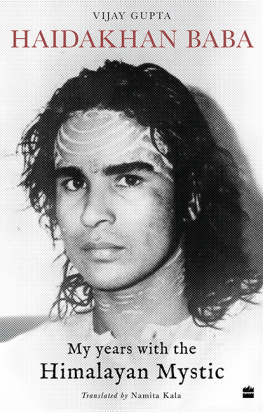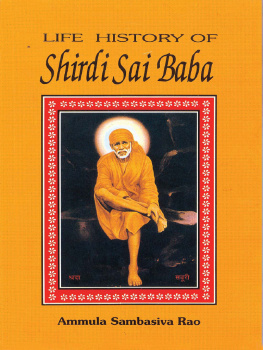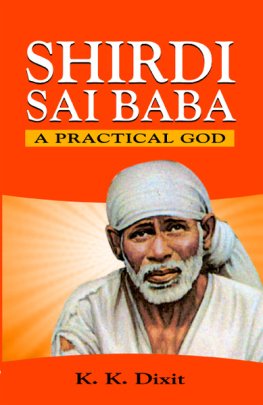Table of Contents


Dedicated to the lotus feet of Haidakhan Baba
CONTENTS

W ell-entrenched in Hinduism is the belief that God sometimes descends to earth as an avatar, that is, the manifestation of a deity that has assumed human form for some divine purpose. An avatar may also be defined as an incarnate divine teacher. Haidakhanwale Baba, or simply Baba Haidakhan, about whom this book has been written, qualifies as an avatar on both counts. He appeared out of a cave in 1970 near Haidakhan Village, seemingly out of nowhere, and proceeded to touch and transform the lives of millions of devotees who encountered Him. He taught us the eternal precepts of Truth, Simplicity and Love and emphasized the importance of Karma Yoga and Japa Yoga as protective shields in the troubled New Age we would be stepping intothe world in which we live today.
To trace the origins of Baba Haidakhan, one has to go back into pre-history to the time of his original incarnation as Mahavatar Baba, also described as Lord Sadashiv in the Shiva Puranas. He is said to have flashed through the millennia from time to time as a Guru Avatar, or in plainer words, an enlightened master, to instruct His followers on the knowledge of the self and lead them to a higher plane of existence.
Unlike the more famous avatars of Lord Vishnu, such as Lord Ram and Lord Krishna, very little is known of Lord Shivas avatars. Apart from Mahavatar Baba, Adi Shankaracharya and Dakshinamurti Bhagwan are also said to have been avatars of Lord Shiva. In fact, according to legend, the former, who gifted the world with Advaita Vedanta, received his initiation from Mahavatar Baba. Similarly, Lord Parashuram, the sixth avatar of Vishnu, is believed to have been sent to Him for penance after he had fulfilled his vow of vengeance to destroy all the kshatriyas in the world.
The prominent Shaivite revivalist, Lakulisha, credited with establishing the doctrine of the Pashupata and twelve jyotirlingas (Lord Shiva represented in phallic form) around India, is believed to have been an early manifestation of Babaji around 125 CE. Another manifestation of Babaji graced Tibet some six centuries ago as the well-known saint, Lama Baba.
In recent times, Lord Shiva has appeared on earth as Haidakhan Baba not once but twice. He appeared for the first time in the 1830s and trod the earth for a span of about ninety-odd years in this incarnation, enrapturing his followers with the many miracles He performed. He was last seen walking on the confluence of the rivers Kali-Gori in 1922 by a group of devotees, before turning into a ball of light and disappearing skywards. After a gap of nearly fifty years, He appeared once again in 1970 in the same village of Haidakhan which He had established in his previous incarnation, this time as a younger-looking eighteen-year-old boy. (It may be noted here that the old Haidakhan Baba was described as the Mahavatar Baba by both Paramhansa Yogananda and Lahiri Mahashaya).
The appearance of Lord Shiva as Haidakhan Baba was foretold in the famous Indian astrological treatise, the Bhrigu Samhita, written by the famous ancient astrologer saint, Maharishi Bhrigu. When Babaji reappeared in His last incarnation, He spotted the young Vijay Gupta in Jaipur.
The author, Vijay Gupta, writes that he underwent his first mystical experience linked to Babaji at the Kathghariya Ashram as a thirteen-year-old before He reappeared. A few years later, after His prakatya (appearance), Babaji noticed the young Vijay, who was around sixteen at the time, and handpicked him as His personal buddy-cum-companion. Vijay went on to spend the remaining three years of his teenage life serving Babaji or, as he described itliving in the company of God.
Peppered with innumerable gripping, often funny, and always meaningful anecdotes, Haidakhan Baba: My Years with the Himalayan Mystic, is an eye-opener for the reader. It is a detailed and personal account of Vijay Guptas spiritual journey, beginning with his boyhood spent with Lord Shiva in human form to his years as a young man, distracted by the world of politics, heedless of Babajis warning that he would gain nothing by it; it records his subsequent disillusionment with the political firmament till he finally comes full circle back into the world which he had never really left. Tightly interwoven into the narrative is his unwavering, unshaken bond with Babaji, to which he remained true, even when he was at odds with Him.
A riveting account of Gods various leelas in His latest incarnation, the book gives the reader a microscopic view of Vijays life with Babaji, narrating to hilarious effect how he is often baffled by the inscrutable workings of His mysterious ways and divine purpose.
Haidakhan Baba is a tale of God in human form written by the chosen one. The book inevitably leads the reader to compare Vijay to Lord Rams younger brother, Lakshman, or Lord Krishnas friend, Sudama.
Vijays experiences are truly out of this world and are not likely to ever be repeated by any mortal soul who has been blessed with the company of God in human form. Vijay learns, first hand, the true meaning of love, truth and simplicity from his divine master. The book is a must-read for all spiritual seekers, as it serves as a guide to all those who are on a quest to understand what it is like to eat, live and sleep with Divinity.
(Honorary) Brigadier Dr Arvind Lal, Padma Shri,
Chairman, HaidakhandiSamaj

G urus have attracted accolades and reverence in all the religions of this world, because human prosperity and the redressal of evil and ill-fortune are only possible by the divine grace of a holy teacher. In our own era, Baba Haidakhans descent to this world is worthy of veneration. His appearance itself is an impenetrable mystery, as no one really knows from where He came.
I have tried to faithfully recount the fourteen years that Babaji spent on this earth as accurately as memory permits, as providence provided me with the great good luck of following His divine footsteps and ascending several ladders of service in the period that I served Him.
Baba Haidakhan was a vitaraga karma yogi (a person who performs his duty without attachment) whose life reflected a natural transparency and simplicity. He empowered His devotees with diligence and was as much a servitor as they were, in every construction activity He undertook. Babaji did not administer discipline or sermonize from a lofty, remote pedestal. He worked shoulder to shoulder with them to help them achieve their dreams.
For the past two decades, Baba Haidakhan has been worshipped in Uttarakhand whilst simultaneously being recognized as a Chiranjeevi. Babaji stepped on to this earth to propagate dharma (virtue, duty), destroy adharma (evil), work for the greatest good and promote happiness during the course of His incarnation. He filled devotees with the joy of unwavering faith and endowed them with bliss through His myriad leelas (divine play, miracles).
In this book, I have striven to present the truth about Babaji as I saw it, knitting those rich experiences with all the beauty and feeling that I underwent at the time. Baba Haidakhan tried to provide His disciples with the right props to enable them to overcome the hardships of this world. It is with the hope that Babaji will continue to bless His followers with good fortune and grace them with His divine blessings that I write this book.















